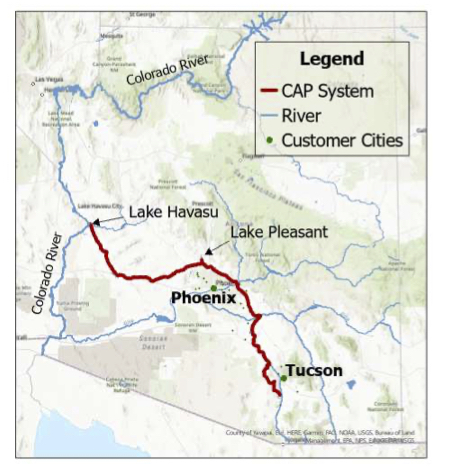Center on Financial Risk in Environmental Systems: Central Arizona
Central Arizona
Project Title:
Improving Resiliency for Large-Scale Water Suppliers Facing Drought-Related Financial Risk
Summary:
Hydrologic variability presents significant challenges to water providers in terms of managing supply risk, but resilient systems must also manage the corresponding financial risk. During drought, water providers pump less water, make fewer water deliveries, and earn less revenue, placing them at risk for meeting their firm costs (e.g., debt payments) unless they raise prices or find alternative funds to offset price increases.

Description:
During drought water providers pump less water, make fewer water deliveries, and earn less revenue. Meanwhile, their costs are mostly fixed, with a large fraction linked to debt service resulting from the capital-intensive development of water supply infrastructure. The consequent budget shortfalls can be disruptive and must be managed effectively if this critical infrastructure is to remain resilient in a future with increasingly frequent and severe droughts. This research uses an object-oriented modeling approach to provide new insights into ways in which large water providers can better quantify and manage their financial risk and establish strategies for promoting greater financial resiliency in the face of climate change. This work involves a case study of the Central Arizona Project (CAP), one of the largest water providers in the Western U.S. Current reductions in CAP’s access to Colorado River water will reduce its water deliveries by 40% this year, resulting in substantially lower revenues. In response, CAP will raise its wholesale water prices significantly to meet its costs. Variability in electricity prices may impose additional financial risks, as droughts and heatwaves are often correlated and the latter can raise CAP’s electricity costs (30% of its total). As an alternative to increasing wholesale water delivery prices, CAP could offset some of the price increases by utilizing a portion of its reserve and/or tax funds. Results suggest that CAP’s use of these offsetting funds could limit annual price increases through 2030 under wet and normal conditions, but that drier conditions would be much more problematic.
Collaborators:
Juliet Homer, Pacific Northwest National Laboratory
Dr. Kostas Oikonomou, Pacific Northwest National Laboratory
Related Publication:
[superscripts denoting graduate students (M = masters; D = doctoral) and Post-doctoral Researchers (P) or Researchers (R)) working in CoFiRES]
Haley, M.M, Gorelick, D. E.P, Characklis, G. W., Kleiman, R., Homer, J. and K. Oikonomou. “Improving Resiliency for Large-scale Water Suppliers facing Drought-related Financial Risk,” IEEE Xplore (in review).
Funding Support:
Pacific Northwest National Laboratory
U.S. Department of Energy
